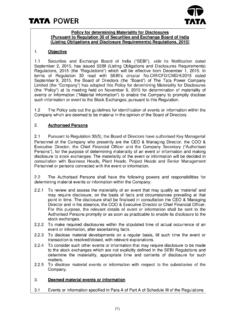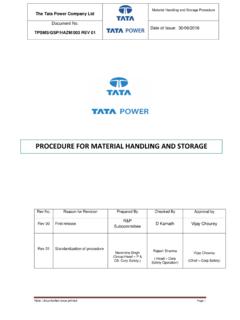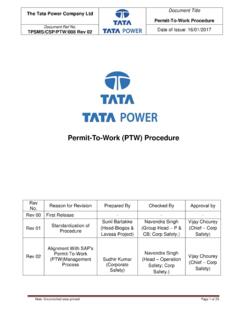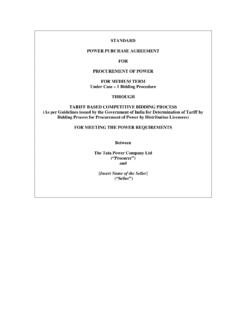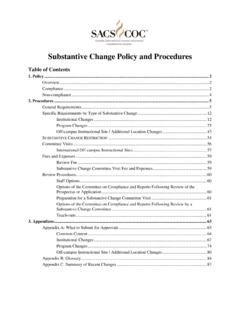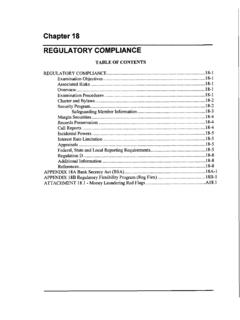Transcription of Mobile Crane Safety Procedure - Tata Power
1 Note: Uncontrolled once printed Page 1 of 27 The Tata Power Company Ltd Document Title: Mobile Crane Safety Procedure Document Ref No. TPSMS/CSP/MCS/006 Rev 01 Date of Issue: 01/01/2016 Mobile Crane Safety Procedure Rev No. Reason for Revision Prepared By Checked By Approval by Rev 00 First release R&P Sub Committee D Kamath Vijay Chourey Rev 01 Standardization of Procedure Sambit Kumar Sahoo (Group Head (Mechanical) -Core Technology) Navendra Singh (Group Head P Corp Safety .) Vijay Chourey (Chief Corp Safety ) Note: Uncontrolled once printed Page 2 of 27 The Tata Power Company Ltd Document Title: Mobile Crane Safety Procedure Document Ref No. TPSMS/CSP/MCS/006 Rev 01 Date of Issue: 01/01/2016 Contents Section Description Page No. OBJECTIVE 3 SCOPE 3 EXPECTED RESULTS 3 ACCOUNTABILITY & RESPONSIBILTIY 3 GLOSSARY/ DEFINITIONS 5 procedures 8 RECORDS 16 TRAINING & COMMUNICATION 16 VERIFICATION 16 EXCEPTIONS 16 REFERENCES 16 REVIEW 17 ATTACHMENTS/APPENDIX 17 - Annexure 1: Daily/Periodic Mobile Crane Check List (TPSMS/CSP/MCS/006/FORM/001) 18 - Annexure 2: Timber Pads required under Outriggers- Examples 19 - Annexure 3: Checks & Maintenance for Crane rope & hook 21 - Annexure 4: Mobile Crane Planning & Risk Assessment Guidelines 24 Annexure 5:Signage for Height Restriction (Example Illustration) 26 Annexure 6: Load chart for Mobile Crane -90 Ton, Boom length 11-50 M (Typical) 27 Note: Uncontrolled once printed Page 3 of 27 The Tata Power Company Ltd Document Title: Mobile Crane Safety Procedure Document Ref No.
2 TPSMS/CSP/MCS/006 Rev 01 Date of Issue: 01/01/2016 1. OBJECTIVE: Objective of this Procedure is to provide minimum requirements for safe operation of Mobile cranes and to establish mandatory requirements and practices to protect personnel & property from hazards associated with Mobile Crane related jobs. 2. SCOPE: This Procedure applies to all operating and project sites of Tata Power Group companies. 3. EXPECTED RESULTS: Manage jobs related to Mobile Crane safely. Control of incidents related to Mobile Crane operation. Compliance to Regulatory requirements related to Mobile Crane & Lifting tools. 4. ACCOUNTABILITY & RESPONSIBILITY: ACCOUNTABILITY: Concerned Division s Heads/Assets Custodian. RESPONSIBILITY: Lift Engineer/ Supervisor: Shall check suitability of Crane referring Load chart & raise the request in prescribed format including all details. Load Chart will be provided by the Crane supplier / contractor (Refer Annexure -6 for load Chart).
3 Completion of mandatory requirements such as vehicle entry permit, Risk assessment. Use tested lifting tool-tackles of appropriate capacity (sling / synthetic belt / D-shackle / tailing hook etc.) Shall prepare Lifting plan for all critical lifts. Ensure Area/ground preparation will be done wherever required. It will be done with consultation of SBU/Site - Civil Engineer if Crane is required to position on soft soil.(For supporting Crane outriggers sufficient wooden blocks/thick metal sheets will be placed on soft soil) Ensure tool box talk of all movements & rigging operations. He shall discuss rigging plan with rigger, signal man & Crane operator for safe execution of job. Ensure operating locations are far enough away from shoring, excavations, trenches, buried utilities, foundations, etc. to eliminate the risk of collapse. Signalman & Riggers: Shall follow Procedure to use Mobile Crane , best rigging practice for safe operation of Crane .
4 Shall use only lifting tools which are tested & of appropriate capacity. Rigging foreman/signal man shall identify himself by wearing reflective jacket. Crane Operators responsibilities: Check ground condition & position the Crane . Note: Uncontrolled once printed Page 4 of 27 The Tata Power Company Ltd Document Title: Mobile Crane Safety Procedure Document Ref No. TPSMS/CSP/MCS/006 Rev 01 Date of Issue: 01/01/2016 Crane Operator shall check all interlock & Safety devices are in working condition. He will inform his supervisor & concern plant engineer if anyone is not in working condition. ( Anti two blocking, Safe Load Indicator) The operator must understand its functions and limitations as well as its particular operating characteristics. Having a thorough knowledge of the information contained in the Crane 's operating manual. Familiar with the Crane 's load chart (Refer Annexure -6 for load Chart).
5 The operator must understand the correct meaning of all notes and warnings and be able to calculate or determine the Crane 's actual net capacity for every possible configuration of the machine. Inspecting and maintaining the Crane regularly as prescribed by both the owner and manufacturer. Informing the owner of any problems, needed maintenance, or necessary repairs to the machine. This should be done in writing, preferably in the machine's logbook or inspection report. Recording in the log or report the details of all inspections, maintenance, and other work done on the Crane while in the field. Supervising and training the apprentice if one is present. Being aware of any site conditions that could affect the Crane operation. Be particularly cautious around Power lines. The operator must refuse to operate if the Crane , hoist rope, or load will come closer to a Power line than the absolute limit of approach specified in law.
6 Checking that the site is adequately prepared for the Crane . Reviewing the planned operation and requirements with the site supervision. Finding out the load and rigging weight and determining where the load is to be placed. Although the operator is not responsible for determining the weight of the load, if the operator lifts it without checking the weight with site supervision, then the operator becomes fully responsible for the lift and any consequences that result. Checking the load chart to ensure that the Crane has sufficient net lifting capacity for every lift (Refer Annexure -6 for load Chart). Selecting (from the range diagram) the best boom, jib, and Crane configuration to suit the load, site and lift conditions. Assembling, setting up and rigging the Crane properly. Following the manufacturer's operating instructions in accordance with the load chart. Considering all factors that might reduce Crane lift capacity and adjusting the load weight to suit.
7 This will include such factors as weather conditions and ground conditions. Note: Uncontrolled once printed Page 5 of 27 The Tata Power Company Ltd Document Title: Mobile Crane Safety Procedure Document Ref No. TPSMS/CSP/MCS/006 Rev 01 Date of Issue: 01/01/2016 Knowing basics of rigging procedures and ensuring that they are applied (this is possible only when the load is visible to the operator). Maintaining communication with signalman & riggers. Operating Mobile Crane in a smooth, controlled, and safe manner. Shutting down and securing the machine properly when it is unattended. Exercising the right to refuse to operate the Crane if there is cause to suspect the lift might be unsafe. Holding Vehicle Fitness Certificate / copy of valid license / Safety card document. Equipment handing checklist should available with operator prior to lift if the load above two MT. Conduct functional tests prior to using the equipment.
8 At the beginning of each operator's shift, the upper limit switch (anti-two-block) of each hoist shall be tried out under no load. Extreme care shall be exercised; the block protection shall be kept in line. While any employee is touching the load or hook, there shall be no hoisting, lowering, or traveling. 5. GLOSSARY/ DEFINITIONS: Attachment description - List type of slings; belts, wire ropes, chains, shackles etc. to be used to attach the load, if required make a simple sketch under lift description. Anti-two-blocking device - a device that, when activated, disengages all Crane functions whose movement can cause two-blocking. Abnormal operating conditions Environmental conditions that are unfavorable, Harmful, or detrimental to the operation of a Mobile Crane ( , excessively high or low ambient temperatures, exposure to weather, corrosive fumes, dust-laden or Moisture-laden atmospheres, and hazardous locations).
9 Approver: Location Manager in charge of plant/dept. Authorized shall be as per the permit to work Procedure . Competent person - one who is capable of identifying existing and predictable deficiencies in Mobile cranes and boom trucks. Critical lift A lift using an Mobile Crane where, because of the characteristics and properties or travel path of the load, a hoist failure or loss of control of the load could result in a serious personal injury, serious environmental incident, serious process Safety incident, or significant disruption to operations. Critical Lift shall contain one or more of following criteria a. Tandem Lift (use of two or more cranes simultaneously) b. Capacity utilization of Crane exceeding over 85%. c. lifting of man using Crane boom d. Travel path crossing over process plant/process pipelines e. Cost of load exceeding one Million Rupees. Note: Uncontrolled once printed Page 6 of 27 The Tata Power Company Ltd Document Title: Mobile Crane Safety Procedure Document Ref No.
10 TPSMS/CSP/MCS/006 Rev 01 Date of Issue: 01/01/2016 Capacity loading - It will be calculated by dividing the total weight with the safe workload at lift radius. It shall not exceed 85% of Mobile Crane . For capacity loading above 85% a lifting plan is required. No capacity loading above 100% shall be allowed, equal to 90% of load test. If Safe Load Indicator is not installed the capacity loading shall not exceed 60%; if above a lifting plan is required. For lifting personnel the capacity loading must be below 50%. Emergency operations - operations that include fire, Power line contact, loss of stability, or control malfunction. Eccentric Load - Load center of gravity does not correspond to the geometrical center, an unevenly loaded container. In case of eccentric load for heavy loads, say above 2 Tons, center of gravity should be calculated and lifting points defined accordingly. For light loads the most practical is to determine the center of gravity by trial and error without lifting the load completely off the ground.


